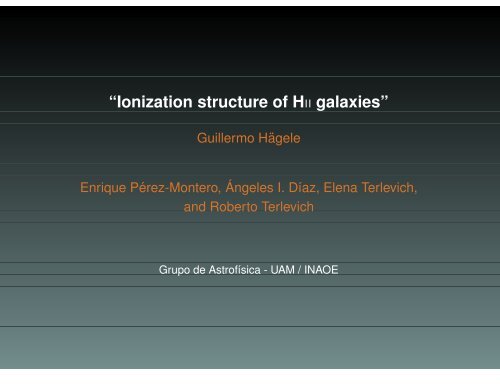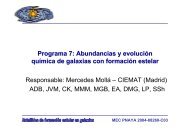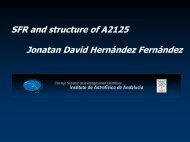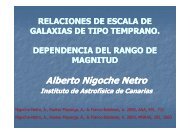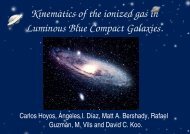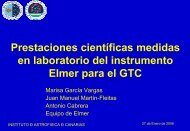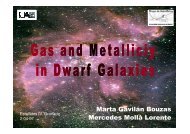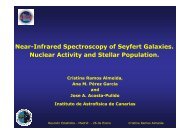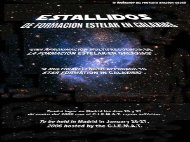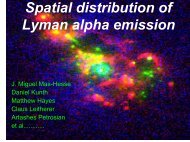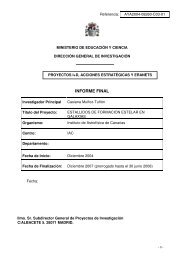“Ionization structure of HII galaxies”
âIonization structure of HII galaxiesâ
âIonization structure of HII galaxiesâ
Create successful ePaper yourself
Turn your PDF publications into a flip-book with our unique Google optimized e-Paper software.
<strong>“Ionization</strong> <strong>structure</strong> <strong>of</strong> <strong>HII</strong> <strong>galaxies”</strong><br />
Guillermo Hägele<br />
Enrique Pérez-Montero, Ángeles I. Díaz, Elena Terlevich,<br />
and Roberto Terlevich<br />
Grupo de Astr<strong>of</strong>ísica - UAM / INAOE
Introduction:<br />
- <strong>HII</strong> galaxies are low mass irregular galaxies with, at least, a recent episode <strong>of</strong> violent<br />
star formation concentrated in a few parsecs close to their cores.
Introduction:<br />
- <strong>HII</strong> galaxies are low mass irregular galaxies with, at least, a recent episode <strong>of</strong> violent<br />
star formation concentrated in a few parsecs close to their cores.<br />
- The ionizing fluxes originated by these young massive stars dominate the light, the<br />
ionization degree and temperature <strong>of</strong> their interstellar gas.
Introduction:<br />
- <strong>HII</strong> galaxies are low mass irregular galaxies with, at least, a recent episode <strong>of</strong> violent<br />
star formation concentrated in a few parsecs close to their cores.<br />
- The ionizing fluxes originated by these young massive stars dominate the light, the<br />
ionization degree and temperature <strong>of</strong> their interstellar gas.<br />
- Thus, these systems have an emission line spectrum very similar to those <strong>of</strong> the<br />
extragalactic giant <strong>HII</strong> regions.
Introduction:<br />
- <strong>HII</strong> galaxies are low mass irregular galaxies with, at least, a recent episode <strong>of</strong> violent<br />
star formation concentrated in a few parsecs close to their cores.<br />
- The ionizing fluxes originated by these young massive stars dominate the light, the<br />
ionization degree and temperature <strong>of</strong> their interstellar gas.<br />
- Thus, these systems have an emission line spectrum very similar to those <strong>of</strong> the<br />
extragalactic giant <strong>HII</strong> regions.<br />
- The physical properties <strong>of</strong> these objects are usually derived combining photoionization<br />
model results and observed emission line intensity ratios.
Introduction:<br />
- <strong>HII</strong> galaxies are low mass irregular galaxies with, at least, a recent episode <strong>of</strong> violent<br />
star formation concentrated in a few parsecs close to their cores.<br />
- The ionizing fluxes originated by these young massive stars dominate the light, the<br />
ionization degree and temperature <strong>of</strong> their interstellar gas.<br />
- Thus, these systems have an emission line spectrum very similar to those <strong>of</strong> the<br />
extragalactic giant <strong>HII</strong> regions.<br />
- The physical properties <strong>of</strong> these objects are usually derived combining photoionization<br />
model results and observed emission line intensity ratios.<br />
- However, there are several major unsolved problems that limit the confidence <strong>of</strong><br />
present results, among them:<br />
(1) the effect <strong>of</strong> temperature <strong>structure</strong> in multiple-zone models (Pérez-Montero & Díaz<br />
2003, PMD03)<br />
(2) the presence <strong>of</strong> temperature fluctuations across the nebula (Peimbert 1967, ...)<br />
(3) collisional and density effects on ion temperatures (Luridiana et al. 1999, PMD03)<br />
(4) the ionization <strong>structure</strong> not adequately reproduced by current models (PMD03)
Observations:<br />
- In order to be able to solve these problems they are needed good quality spectra, with<br />
good S/N and spectral range.
¢<br />
¡<br />
£<br />
£¤<br />
§ ¦<br />
¦ §<br />
© ¦<br />
¨§<br />
£<br />
¦<br />
¥<br />
¢<br />
Observations:<br />
- In order to be able to solve these problems they are needed good quality spectra, with<br />
good S/N and spectral range.<br />
- Our objects were selected from the whole SDSS DR2 spectral catalog using the INAOE<br />
Virtual Observatory superserver<br />
Selection criteria: emission line galaxies with EW(H<br />
50 Å, 1.2<br />
(H<br />
)<br />
7 Å,<br />
z<br />
0.2, F(H<br />
)<br />
4<br />
10<br />
erg cm<br />
s<br />
Å
¢<br />
¡<br />
£<br />
£¤<br />
¨§<br />
§<br />
¦ §<br />
© ¦<br />
£<br />
¦<br />
¦<br />
¥<br />
¢<br />
Observations:<br />
- In order to be able to solve these problems they are needed good quality spectra, with<br />
good S/N and spectral range.<br />
- Our objects were selected from the whole DR2 spectral catalog using the INAOE<br />
Virtual Observatory superserver<br />
Selection criteria: emission line galaxies with EW(H<br />
50 Å, 1.2<br />
(H<br />
)<br />
7 Å,<br />
z<br />
0.2, F(H<br />
)<br />
4<br />
10<br />
erg cm<br />
s<br />
Å<br />
- This preliminary list was processed using BPT (Baldwin, Phillips & Terlevich 1981)<br />
diagnostic diagrams in order to remove AGNs (Jesús López, MSc Thesis, INAOE, 2005).
£¤<br />
¢<br />
¡<br />
£<br />
¨§<br />
§<br />
¦ §<br />
© ¦<br />
£<br />
¦<br />
¦<br />
¥<br />
¢<br />
Observations:<br />
- In order to be able to solve these problems they are needed good quality spectra, with<br />
good S/N and spectral range.<br />
- Our objects were selected from the whole DR2 spectral catalog using the INAOE<br />
Virtual Observatory superserver<br />
Selection criteria: emission line galaxies with EW(H<br />
50 Å, 1.2<br />
(H<br />
)<br />
7 Å,<br />
z<br />
0.2, F(H<br />
)<br />
4<br />
10<br />
erg cm<br />
s<br />
Å<br />
- This preliminary list was processed using BPT (Baldwin, Phillips & Terlevich 1981)<br />
diagnostic diagrams in order to remove AGNs (Jesús López, MSc Thesis, INAOE, 2005).<br />
- Then, by an independent visual inspection <strong>of</strong> each object we have selected the final<br />
sample.
£¤<br />
¢<br />
¡<br />
£<br />
¨§<br />
§<br />
¦ §<br />
© ¦<br />
¥<br />
¢<br />
£<br />
¦<br />
¦<br />
Observations:<br />
- In order to be able to solve these problems they are needed good quality spectra, with<br />
good S/N and spectral range.<br />
- Our objects were selected from the whole DR2 spectral catalog using the INAOE<br />
Virtual Observatory superserver<br />
Selection criteria: emission line galaxies with EW(H<br />
50 Å, 1.2<br />
(H<br />
)<br />
7 Å,<br />
z<br />
0.2, F(H<br />
)<br />
4<br />
10<br />
erg cm<br />
s<br />
Å<br />
- This preliminary list was processed using BPT (Baldwin, Phillips & Terlevich 1981)<br />
diagnostic diagrams in order to remove AGNs (Jesús López, MSc Thesis, INAOE, 2005).<br />
- Then, by an independent visual inspection <strong>of</strong> each object we have selected the final<br />
sample.<br />
- The SDSS spectroscopic data have a resolution (R) <strong>of</strong> 1800-2100 covering a spectral<br />
range from 3800 to 9200 Å, with a single 3” diameter aperture.
£¤<br />
¢<br />
¡<br />
£<br />
¨§<br />
§<br />
¦ §<br />
© ¦<br />
¥<br />
¢<br />
£<br />
¦<br />
¦<br />
Observations:<br />
- In order to be able to solve these problems they are needed good quality spectra, with<br />
good S/N and spectral range.<br />
- Our objects were selected from the whole DR2 spectral catalog using the INAOE<br />
Virtual Observatory superserver<br />
Selection criteria: emission line galaxies with EW(H<br />
50 Å, 1.2<br />
(H<br />
)<br />
7 Å,<br />
z<br />
0.2, F(H<br />
)<br />
4<br />
10<br />
erg cm<br />
s<br />
Å<br />
- This preliminary list was processed using BPT (Baldwin, Phillips & Terlevich 1981)<br />
diagnostic diagrams in order to remove AGNs (Jesús López, MSc Thesis, INAOE, 2005).<br />
- Then, by an independent visual inspection <strong>of</strong> each object we have selected the final<br />
sample.<br />
- The SDSS spectroscopic data have a resolution (R) <strong>of</strong> 1800-2100 covering a spectral<br />
range from 3800 to 9200 Å, with a single 3” diameter aperture.<br />
- The data were reduced and flux-calibrated using automatic pipelines.
Observations: WHT<br />
- The intermediate resolution blue and far red longslit spectra were obtained<br />
simultaneously during an observing run <strong>of</strong> one night using the ISIS double beam<br />
spectrograph <strong>of</strong> the WHT.<br />
Spectral range Disp. FWHM Spatial res.<br />
blue 3200-5700 0.86Å 2.5Å 0.2”/px<br />
red 5500-10550 1.64Å 4.8Å 0.2”/px<br />
2.4e-15<br />
2.1e-15<br />
[OII] 3727<br />
Ηβ<br />
[OIII] 4959<br />
[OIII] 5007<br />
1.4e-15<br />
1.2e-15<br />
Ηα<br />
1.8e-15<br />
Flux (erg cm -2 s -1 Å -1 )<br />
1.5e-15<br />
1.2e-15<br />
9e-16<br />
6e-16<br />
3e-16<br />
[NeIII] 3868<br />
Ηδ<br />
Ηγ<br />
[OIII] 4363<br />
Flux (erg cm -2 s -1 Å -1 )<br />
1e-15<br />
8e-16<br />
6e-16<br />
4e-16<br />
2e-16<br />
HeI 5876<br />
[SIII] 6312<br />
[SII] 6717,6731<br />
[OII] 7319,7330<br />
[SIII] 9069<br />
[SIII] 9532<br />
3500 4000 4500 5000 5500<br />
Wavelength ( Å )<br />
6000 6500 7000 7500 8000 8500 9000 9500<br />
Wavelength ( Å )
Observations: WHT<br />
- The intermediate resolution blue and far red longslit spectra were obtained<br />
simultaneously during an observing run <strong>of</strong> one night using the ISIS double beam<br />
spectrograph <strong>of</strong> the WHT.<br />
- We have chosen the spectral range to measure simultaneously the Balmer<br />
discontinuity, and the nebular lines [OII] 3727 and [SIII] 9069, 9532. Moreover, we have<br />
measured other important lines such as [OIII] 4363, 4959, 5007, [SII] 4068, 6717, 6731,<br />
and [SIII] 6312.<br />
2.4e-15<br />
2.1e-15<br />
[OII] 3727<br />
Ηβ<br />
[OIII] 4959<br />
[OIII] 5007<br />
1.4e-15<br />
1.2e-15<br />
Ηα<br />
1.8e-15<br />
Flux (erg cm -2 s -1 Å -1 )<br />
1.5e-15<br />
1.2e-15<br />
9e-16<br />
6e-16<br />
3e-16<br />
[NeIII] 3868<br />
Ηδ<br />
Ηγ<br />
[OIII] 4363<br />
Flux (erg cm -2 s -1 Å -1 )<br />
1e-15<br />
8e-16<br />
6e-16<br />
4e-16<br />
2e-16<br />
HeI 5876<br />
[SIII] 6312<br />
[SII] 6717,6731<br />
[OII] 7319,7330<br />
[SIII] 9069<br />
[SIII] 9532<br />
3500 4000 4500 5000 5500<br />
Wavelength ( Å )<br />
6000 6500 7000 7500 8000 8500 9000 9500<br />
Wavelength ( Å )
Observations: WHT<br />
- The intermediate resolution blue and far red longslit spectra were obtained<br />
simultaneously during an observing run <strong>of</strong> one night using the ISIS double beam<br />
spectrograph <strong>of</strong> the WHT.<br />
- We have chosen the spectral range to measure simultaneously the Balmer<br />
discontinuity, and the nebular lines [OII] 3727 and [SIII] 9069, 9532. Moreover, we have<br />
measured other important lines such as [OIII] 4363, 4959, 5007, [SII] 4068, 6717, 6731,<br />
and [SIII] 6312.<br />
- All the WHT data were reduced using IRAF routines in the usual manner.
Measurements:<br />
- There are some differences between the measurements <strong>of</strong> the observed fluxes taken<br />
with both WHT and SDSS telescopes.
Measurements:<br />
- There are some differences between the measurements <strong>of</strong> the observed fluxes taken<br />
with both WHT and SDSS telescopes.<br />
- A possible explanation <strong>of</strong> these differences are the different apertures <strong>of</strong> the WHT and<br />
Sloan data, 0.5 and 3”, we are observing different zones <strong>of</strong> the galaxies.
Measurements:<br />
- There are some differences between the measurements <strong>of</strong> the observed fluxes taken<br />
with both WHT and SDSS telescopes.<br />
- A possible explanation <strong>of</strong> these differences are the different apertures <strong>of</strong> the WHT and<br />
Sloan data, 0.5 and 3”, we are observing different zones <strong>of</strong> the galaxies.<br />
- Then, the reddening constant, temperatures, densities and abundances derived using<br />
WHT and Sloan data may differ.
Physical conditions:<br />
- Electron temperatures and electron density have been computed from the emission line<br />
data using the five-level statistical equilibrium model in the task TEMDEN <strong>of</strong> IRAF<br />
(Pérez-Montero & Díaz 2003).
Physical conditions:<br />
- Electron temperatures and electron density have been computed from the emission line<br />
data using the five-level statistical equilibrium model in the task TEMDEN <strong>of</strong> IRAF<br />
(Pérez-Montero & Díaz 2003).<br />
- The emission-line ratios used to calculate each available temperature and density are<br />
Diagnostic<br />
n([SII])<br />
T([OIII])<br />
T([OII])<br />
T([SIII])<br />
T([SII])<br />
T([NII])<br />
Lines<br />
I(6717Å)/I(6731Å)<br />
(I(4959Å)+I(5007Å))/I(4363Å)<br />
I(3729Å)/(I(7319Å)+I(7330Å))<br />
(I(9069Å)+I(9532Å))/I(6312Å)<br />
(I(6717Å)+I(6731Å))/(I(4068Å)+I(4074Å))<br />
(I(6548Å)+I(6584Å))/I(5755Å)
Physical conditions:<br />
- Electron temperatures and electron density have been computed from the emission line<br />
data using the five-level statistical equilibrium model in the task TEMDEN <strong>of</strong> IRAF<br />
(Pérez-Montero & Díaz 2003).<br />
- The emission-line ratios used to calculate each available temperature and density are<br />
Diagnostic<br />
n([SII])<br />
T([OIII])<br />
T([OII])<br />
T([SIII])<br />
T([SII])<br />
T([NII])<br />
Lines<br />
I(6717Å)/I(6731Å)<br />
(I(4959Å)+I(5007Å))/I(4363Å)<br />
I(3729Å)/(I(7319Å)+I(7330Å))<br />
(I(9069Å)+I(9532Å))/I(6312Å)<br />
(I(6717Å)+I(6731Å))/(I(4068Å)+I(4074Å))<br />
(I(6548Å)+I(6584Å))/I(5755Å)<br />
- In one <strong>of</strong> the SDSS spectra (SDSS J003218.59+150014.2) it is not possible to<br />
calculate T([OII]).
¨<br />
<br />
<br />
¦<br />
Physical conditions:<br />
- When we can not measure the lines necessary to estimate a specific temperature we<br />
used relationships based on the grids <strong>of</strong> photoionization models.<br />
SDSS J003218.60+150014.2<br />
WHT<br />
SDSS<br />
n([SII]) 67: 56:<br />
T([OIII]) 1.29<br />
T([OII]) 1.47<br />
T([OII])<br />
1.35<br />
T([SIII]) 1.32<br />
T([SIII])<br />
1.27<br />
T([SII]) 0.91<br />
0.02 1.28<br />
0.05 —<br />
0.02 1.36<br />
0.07 —<br />
0.02 1.27<br />
0.04 0.92<br />
T([NII]) — —<br />
T([NII])<br />
densities in<br />
1.47<br />
0.05 1.36<br />
0.03<br />
0.02<br />
0.03<br />
0.06<br />
0.02<br />
and temperatures in 10<br />
K
¨<br />
<br />
<br />
¦<br />
Physical conditions:<br />
- When we can not measure the lines necessary to estimate a specific temperature we<br />
used relationships based on the grids <strong>of</strong> photoionization models.<br />
SDSS J162410.11-002202.5<br />
WHT<br />
SDSS<br />
n([SII]) 56: 66:<br />
T([OIII]) 1.24<br />
T([OII]) 1.54<br />
T([OII])<br />
1.33<br />
T([SIII]) 1.36<br />
T([SIII])<br />
1.23<br />
T([SII]) 1.12<br />
T([NII]) 1.42<br />
T([NII])<br />
densities in<br />
1.52<br />
0.01 1.16<br />
0.04 1.23<br />
0.01 1.25<br />
0.05 —<br />
0.01 1.14<br />
0.08 1.02<br />
0.08 —<br />
0.04 1.23<br />
0.01<br />
0.03<br />
0.01<br />
0.01<br />
0.09<br />
0.02<br />
and temperatures in 10<br />
K
Chemical abundances:<br />
- Ionic and total abundances <strong>of</strong> He, O, S, N, Ne, Ar and Fe are obtained using the<br />
stronger available emission lines detected in the studied spectra.
Chemical abundances:<br />
- Ionic and total abundances <strong>of</strong> He, O, S, N, Ne, Ar and Fe are obtained using the<br />
stronger available emission lines detected in the studied spectra.<br />
- Differences between the WHT and SDSS abundances are about 10 % in two cases,<br />
and they are in very good agreement, within the observational errors, in the other.
©<br />
Chemical abundances:<br />
- Ionic and total abundances <strong>of</strong> He, O, S, N, Ne, Ar and Fe are obtained using the<br />
stronger available emission lines detected in the studied spectra.<br />
- Differences between the WHT and SDSS abundances are about 10 % in two cases,<br />
and they are in very good agreement, within the observational errors, in the other.<br />
Relation between the S parameter and<br />
the total oxygen abundance in units <strong>of</strong><br />
12+log(O/H)<br />
Our three objects are in very good<br />
agreement with the empirical calibration<br />
(PMD05).
¡<br />
! <br />
<br />
<br />
<br />
<br />
<br />
¥<br />
<br />
¡<br />
<br />
<br />
<br />
'<br />
&©<br />
%¦<br />
#$<br />
"<br />
¥<br />
<br />
<br />
<br />
<br />
<br />
<br />
Balmer temperature: T(Bac)<br />
– To measure this value we have adjusted the continuum<br />
at both sides <strong>of</strong> the Balmer discontinuity.<br />
– We can only measure the B-jump in the WHT<br />
2.8e-16<br />
2.6e-16<br />
[OII] 3727<br />
H9<br />
[NeIII] 3868<br />
HeI + H8<br />
[NeIII] + H7<br />
spectra due to the SDSS spectral range is not ap-<br />
2.4e-16<br />
H10<br />
propriate.<br />
Flux (erg cm -2 s -1 Å -1 )<br />
2.2e-16<br />
2e-16<br />
1.8e-16<br />
1.6e-16<br />
H17<br />
H16 + HeI<br />
H15<br />
H13<br />
H12<br />
H11<br />
HeI 3820<br />
1.4e-16<br />
BJ<br />
1.2e-16<br />
(Liu et al. 2001)<br />
1e-16<br />
3500 3600 3700 3800 3900 4000<br />
Wavelength ( Å )<br />
T([OIII]) = 1.25<br />
0.02; 1.29<br />
0.02; 1.24<br />
0.01<br />
T(Bac) = 1.23<br />
0.27; 0.96<br />
0.16; 1.24<br />
0.27
¡<br />
¥<br />
<br />
¡<br />
<br />
<br />
<br />
'<br />
¥<br />
<br />
<br />
<br />
<br />
<br />
<br />
<br />
-,<br />
. <br />
<br />
¡+<br />
<br />
0<br />
¡<br />
<br />
0<br />
[OII] 3727<br />
H9<br />
[NeIII] 3868<br />
HeI + H8<br />
[NeIII] + H7<br />
H10<br />
H17<br />
H16 + HeI<br />
H15<br />
H13<br />
H12<br />
H11<br />
HeI 3820<br />
Balmer temperature: T(Bac)<br />
2.8e-16<br />
– To measure this value we have adjusted the continuum<br />
at both sides <strong>of</strong> the Balmer discontinuity.<br />
2.6e-16<br />
– We can only measure the B-jump in the WHT<br />
2.4e-16<br />
2.2e-16<br />
spectra due to the SDSS spectral range is not appropriate.<br />
BJ<br />
2e-16<br />
3500 3600 3700 3800 3900 4000<br />
Wavelength ( Å )<br />
1.8e-16<br />
Flux (erg cm -2 s -1 Å -1 )<br />
! <br />
<br />
<br />
<br />
<br />
<br />
1.6e-16<br />
1.4e-16<br />
&© <br />
%¦<br />
1.2e-16<br />
#$<br />
"<br />
1e-16<br />
(Liu et al. 2001)<br />
0.01<br />
0.02; 1.24<br />
0.02; 1.29<br />
T([OIII]) = 1.25<br />
0.27<br />
0.16; 1.24<br />
0.27; 0.96<br />
T(Bac) = 1.23<br />
– Assuming a one-ionization scheme:<br />
© 3<br />
%21 <br />
/,<br />
" <br />
<br />
)***<br />
(<br />
<br />
51<br />
©6<br />
/, 4
¡<br />
! <br />
<br />
<br />
<br />
<br />
<br />
¥<br />
<br />
¡<br />
<br />
<br />
<br />
'<br />
&©<br />
%¦<br />
#$<br />
"<br />
¥<br />
<br />
<br />
<br />
<br />
<br />
<br />
,<br />
©<br />
<br />
<br />
<br />
<br />
© 3<br />
%21 <br />
<br />
<br />
"<br />
<br />
. <br />
-,<br />
<br />
¡+<br />
)***<br />
(<br />
<br />
,<br />
0<br />
/,<br />
:,<br />
§ ,, ,7 ¦ ,87<br />
¨9 ,,87<br />
©<br />
<br />
9,, ,7 ¦<br />
<br />
51<br />
©6<br />
/, 4<br />
<br />
¡<br />
<br />
0<br />
Balmer temperature: T(Bac)<br />
– To measure this value we have adjusted the continuum<br />
at both sides <strong>of</strong> the Balmer discontinuity.<br />
– We can only measure the B-jump in the WHT<br />
2.8e-16<br />
2.6e-16<br />
[OII] 3727<br />
H9<br />
[NeIII] 3868<br />
HeI + H8<br />
[NeIII] + H7<br />
spectra due to the SDSS spectral range is not ap-<br />
2.4e-16<br />
H10<br />
propriate.<br />
Flux (erg cm -2 s -1 Å -1 )<br />
2.2e-16<br />
2e-16<br />
1.8e-16<br />
1.6e-16<br />
H17<br />
H16 + HeI<br />
H15<br />
H13<br />
H12<br />
H11<br />
HeI 3820<br />
1.4e-16<br />
BJ<br />
1.2e-16<br />
(Liu et al. 2001)<br />
1e-16<br />
3500 3600 3700 3800 3900 4000<br />
Wavelength ( Å )<br />
T([OIII]) = 1.25<br />
0.02; 1.29<br />
0.02; 1.24<br />
0.01<br />
T(Bac) = 1.23<br />
0.27; 0.96<br />
0.16; 1.24<br />
0.27<br />
– Assuming a one-ionization scheme:<br />
Then, the average temperature, T<br />
, and the root<br />
mean square temperature fluctuation, t<br />
, are<br />
T<br />
= 1.24<br />
0.37; 1.08<br />
0.24; 1.24<br />
0.31<br />
t<br />
= 0.005<br />
; 0.069<br />
0.029; 0.001
Recalculated chemical abundances:<br />
- We have recalculated the ionic and total abundances taking into account the<br />
temperature fluctuations (see work by Peimbert et al. ), helped by Jorge García-Rojas<br />
and César Esteban, only for the WHT spectra.
©<br />
Recalculated chemical abundances:<br />
- We have recalculated the ionic and total abundances taking into account the<br />
temperature fluctuations (see work by Peimbert et al. ), helped by Jorge García-Rojas<br />
and César Esteban, only for the WHT spectra.<br />
- There are significant differences only in the case that t<br />
0.15 and 0.25 dex.<br />
=0.069, and they are between
Preliminary conclusions:<br />
- The spectral range <strong>of</strong> SDSS can not be extended with new observations since it is very<br />
difficult to observe the same region <strong>of</strong> the galaxies, and the derived physical properties<br />
may vary.
Preliminary conclusions:<br />
- The spectral range <strong>of</strong> SDSS can not be extended with new observations since it is very<br />
difficult to observe the same region <strong>of</strong> the galaxies, and the derived physical properties<br />
may vary.<br />
- In some cases the temperature fluctuations could be no negligible, but we need more<br />
and better observations to confirm it.
Preliminary conclusions:<br />
- The spectral range <strong>of</strong> SDSS can not be extended with new observations since it is very<br />
difficult to observe the same region <strong>of</strong> the galaxies, and the derived physical properties<br />
may vary.<br />
- In some cases the temperature fluctuations could be no negligible, but we need more<br />
and better observations to confirm it.<br />
- We can estimate the temperature fluctuations and the Balmer temperature since our<br />
observations have a broad spectral range.
Preliminary conclusions:<br />
- The spectral range <strong>of</strong> SDSS can not be extended with new observations since it is very<br />
difficult to observe the same region <strong>of</strong> the galaxies, and the derived physical properties<br />
may vary.<br />
- In some cases the temperature fluctuations could be no negligible, but we need more<br />
and better observations to confirm it.<br />
- We can estimate the temperature fluctuations and the Balmer temperature since our<br />
observations have a broad spectral range.<br />
- We need better quality observations to measure the Paschen discontinuity, and, if it is<br />
possible, recombination lines, e. g. Carbon, Oxygen or Neon lines.
Preliminary conclusions:<br />
- The spectral range <strong>of</strong> SDSS can not be extended with new observations since it is very<br />
difficult to observe the same region <strong>of</strong> the galaxies, and the derived physical properties<br />
may vary.<br />
- In some cases the temperature fluctuations could be no negligible, but we need more<br />
and better observations to confirm it.<br />
- We can estimate the temperature fluctuations and the Balmer temperature since our<br />
observations have a broad spectral range.<br />
- We need better quality observations to measure the Paschen discontinuity, and, if it is<br />
possible, recombination lines, e. g. Carbon, Oxygen or Neon lines.<br />
That’s all, folks!
Measurements:<br />
– For Balmer and Paschen lines a conspicuous<br />
underlying stellar population is easily<br />
appreciable by the presence <strong>of</strong> absorption<br />
features that depress the emission lines.<br />
– We have defined a pseudo-continuum to<br />
measure these line fluxes.<br />
– The absorbed fractions <strong>of</strong> the fluxes are<br />
not the same for all lines, nore the proportions<br />
between the absorbed fractions and<br />
the emissions are the same.<br />
Flux (erg cm -2 s -1 Å -1 )<br />
3.5e-16<br />
3e-16<br />
2.5e-16<br />
2e-16<br />
1.5e-16<br />
[OII] 3727<br />
H13<br />
H12<br />
H11<br />
H10<br />
HeI 3820<br />
H9<br />
[NeIII] 3868<br />
HeI + H8<br />
3800 3900 4000 4100<br />
Wavelength ( Å )<br />
[NeIII] + H7<br />
[NII] + HeI<br />
[SII] 4068<br />
Ηδ
Measurements:<br />
– For Balmer and Paschen lines a conspicuous<br />
underlying stellar population is easily<br />
appreciable by the presence <strong>of</strong> absorption<br />
features that depress the emission lines.<br />
– We have defined a pseudo-continuum to<br />
measure these line fluxes.<br />
– The absorbed fractions <strong>of</strong> the fluxes are<br />
not the same for all lines, nore the propor-<br />
Flux (erg cm -2 s -1 Å -1 )<br />
3.5e-16<br />
3e-16<br />
2.5e-16<br />
2e-16<br />
1.5e-16<br />
[OII] 3727<br />
H13<br />
H12<br />
H11<br />
H10<br />
HeI 3820<br />
H9<br />
[NeIII] 3868<br />
HeI + H8<br />
[NeIII] + H7<br />
[NII] + HeI<br />
[SII] 4068<br />
Ηδ<br />
tions between the absorbed fractions and<br />
the emissions are the same.<br />
3800 3900 4000 4100<br />
Wavelength ( Å )<br />
- The fractional errors introduced by this effect on the four strongest Balmer emission<br />
lines are much lower than that on the other Balmer lines or the Paschen ones.
;<br />
><br />
=<br />
<<br />
Measurements:<br />
– For Balmer and Paschen lines a conspicuous<br />
underlying stellar population is easily<br />
appreciable by the presence <strong>of</strong> absorption<br />
features that depress the emission lines.<br />
– We have defined a pseudo-continuum to<br />
measure these line fluxes.<br />
– The absorbed fractions <strong>of</strong> the fluxes are<br />
not the same for all lines, nore the propor-<br />
Flux (erg cm -2 s -1 Å -1 )<br />
3.5e-16<br />
3e-16<br />
2.5e-16<br />
2e-16<br />
1.5e-16<br />
[OII] 3727<br />
H13<br />
H12<br />
H11<br />
H10<br />
HeI 3820<br />
H9<br />
[NeIII] 3868<br />
HeI + H8<br />
[NeIII] + H7<br />
[NII] + HeI<br />
[SII] 4068<br />
Ηδ<br />
tions between the absorbed fractions and<br />
the emissions are the same.<br />
3800 3900 4000 4100<br />
Wavelength ( Å )<br />
- The fractional errors introduced by this effect on the four strongest Balmer emission<br />
lines are much lower than that on the other Balmer lines or the Paschen ones.<br />
- Then,<br />
(H<br />
) have been calculated using only the four strongest Balmer emission lines<br />
(H<br />
, H<br />
, H<br />
and H<br />
).


